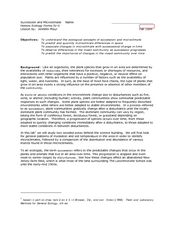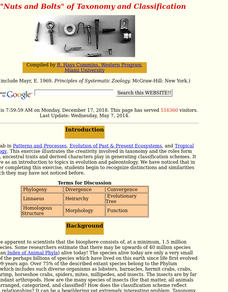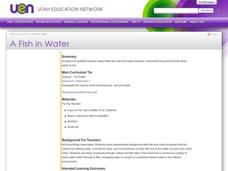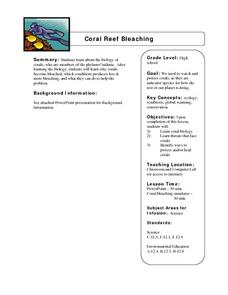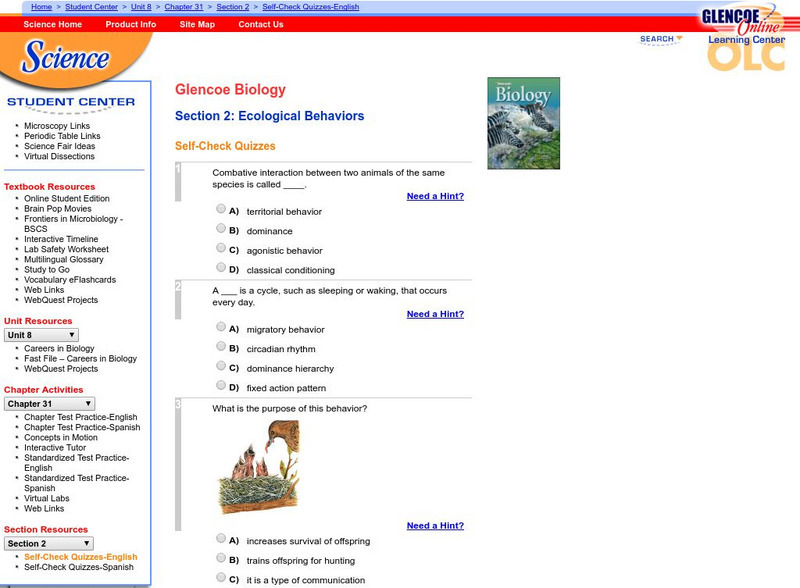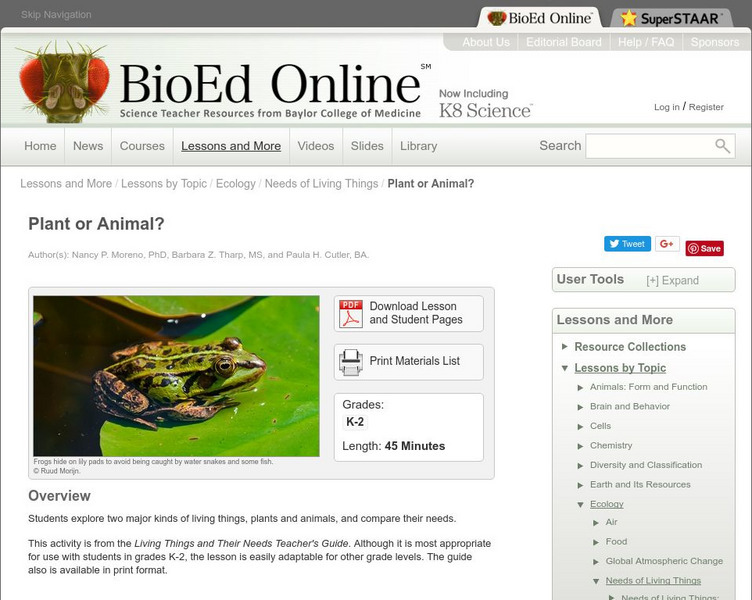Curated OER
Action Verbs
In this grammar instructional activity, students determine which action verb completes nine sentences grammatically correct. Students share their answers with their classmates.
Curated OER
Succession and Microclimate
Students compare the population of insects in different microclimates. In this biology lesson, students collect data using probes to tabulate temperature and soil data. They predict how certain parameters change as an area goes through...
Curated OER
the Wonder of Wetlands
Students explore the importance of the wetland ecosystem, its properties and functions, as well as, the many birds, animals, and plant life found there.
Curated OER
Household Pests
Sixth graders discover the various habitat requirements for assorted household pests from ants to wasps. They conduct various activities including researching the life cycles moths, cockroaches, and mosquitoes
Curated OER
Salinity Of Soil
Fourth graders investigate the contents of various types of soil to determine the differences in salinity levels. They conduct an experiment of observing the plants in the different soils. Students then determine survival rates by...
Curated OER
RIDE THE WILD LEAF
Students identify and interpret that leaves provide food for new trees and plants. Students cut out leaves and glue them on the appropriate
number on included worksheet. Students collect different types of leaves and make leaf rubbings....
Curated OER
The "Nuts and Bolts" of Taxonomy and Classification
Students develop classification scheme that meets the established rules of the Linnaean system. They write one page essay on classification choices.
Curated OER
Cleansing, Sparkling Koos
Students explore the importance of water conservation and investigate how plants clean water.
Curated OER
Lotic Environment
Students assemble a classroom river model as an example of a lotic system. They control and measure biotic and abiotic information for the in-class system and compare data with a lotic system in a natural environment.
Curated OER
Language Arts: Five Senses Walk
First graders take a discovery walk around the school. They use their observations to compose a class book about their school.
Curated OER
A Fish in Water
First graders, with a goldfish as a class pet, practice the proper way to care for a pet and have responsibilities when it comes to taking care of the fish. As a class, the teacher reads the book "Fish Out of Water".
Curated OER
Land Use
Students examine ecosystems that covered Illinois 200 years ago, investigate some living and non-living components of ecosystems, identify components of prairie system, create food webs, and observe human effects on environment. Lessons...
Curated OER
Critters of the Water
Young scholars examine different organisms in various marine habitats. They identify any adaptations that have allowed the organisms to survive. They develop an imaginary organism and describe its life cycle.
Curated OER
Termite Lab
Students examine insect behavior in a lab activity. Students explore the idea of chemical specificity and the reactions of termites to a chemical found in their trail pheromone. Students watch a demonstration with termites before...
Curated OER
Coral Reef Bleaching
Students explore the structural biology of corals. Working individually, students identify how corals become bleached and which conditions produce more and less coral bleaching. Students explore how this effects the environment and...
Curated OER
Lotic Environment Lesson Plans
Learners create and conduct experiments on a "classroom river habitat." They manipulate the biotic and abiotic factors so that they are able to compare an artificially prepared river model to a naturally occurring lotic ecosystem.
Curated OER
Journey of the Salmon
Third graders predict salmon migration routes and explore how dams affect the salmon migration. They explore the cultural significance of salmon to the Nez Perce people and design technology to aid salmon migration.
McGraw Hill
Glencoe Biology: Ecological Behaviors: Self Check Quiz
Take this quick quiz to check comprehension of several ecological survival behaviors of animals.
Regents of the University of Michigan
Animal Diversity Web: Phylum Nematoda
The Animal Diversity Web offers a general introduction to the roundworm and some of its physical characteristics.
BioEd Online
Bio Ed Online: Living Things and Their Needs: Plant or Animal?
For this lesson, students investigate and compare the needs of plants and animals. The lesson can be downloaded in PDF format.
Annenberg Foundation
Annenberg Learner: Habitable Planet: A Systems Approach to Environmental Science
Interdisciplinary multimedia course, in thirteen units, on environmental science. Each unit encompasses a thirty-minute video, an accompanying textbook chapter, and an array of visuals and animations. With five interactive labs, a...
Michigan State University
Michigan State University: Digital Learning Center for Microbial Ecology: Microbe Zoo
Explore the "many worlds of hidden microbes" in different areas of the Microbe Zoo: DirtLand, Animal Pavilion, Snack Bar, Space Adventure, and WaterWorld. A fun and informative resource that sheds light on the role of microbes in our...
Sea World Parks & Entertainment
Animal Bytes: African Elephant
Resource for anyone seeking information on these huge creatures. Provides scientific classification of African Elephants, fast facts, fun facts as well as additional information on ecology and conservation.
Sea World Parks & Entertainment
Animal Bytes: African Cape Buffalo
Provides users with a concise list of information helpful to anyone wanting to know more about these South African ungulates. Contains scientific classification of these animals, fast facts, fun facts as well as additional information on...



